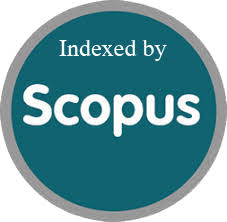The Effect of Routing Protocols on the Performance of Wireless Networks in Versatile Underwater Applications
Abstract
Underwater Sensor Networks (UWSNs) have attracted the research community due to their critical applications, such as environmental monitoring, hurricane tracking, and disaster analysis, to mention a few. This kind of network struggles with many challenges, such as propagation delay and limited energy resources. Many efforts in the literature try to overcome these challenges. However, there is still a need to perform more investigations aiming to obtain more reliable approaches for UWSNs. Therefore, this article suggests an Efficient Energy-Depth Hybrid Routing Protocol (EEDH-RP) that addresses the aforementioned issues. The proposed method integrates energy-efficie and depth-based routing strategies, aiming at optimizing packet delivery and minimizing consumption of powe. The proposed routing involves a hybrid forwarding metric in a way that assumes residual energy and depth information, as well as adaptive transmission power control to improve reliability.The proposed routing is assessed against three well-known routing protocols, namely Vector-Based Forwarding VBF, Depth-Based Routing DBR, and HydroCast Routing HCR. The evaluation involves metrics such as packet delivery ratio, energy consumption, end-to-end delay, network lifetime, and throughput. According to the results, EEDH-RP performed better than the benchmark. It gains 92% for packet delivery ratio, energy consumption of 450 joules (with improvements of 25%, 18%, and 10% for VBF, DBR, and HCR, respectively), and 1.2s for end-to-end delay. Our proposal also extends network lifetime by 28% compared to VBF, and 12% compared to DBR.
References
- A. Mahmood, "Proposed a WebRTC data communication using effective signalling protocol,"Technium, vol. 4, no. 1, pp. 8396, 2022.https://doi.org/10.47577/technium.v4i10.7956
- A. Somani and N. I. Chaubey, Experimental analysis of vector-based forwarding and depth based routing protocols in underwater acoustic sensor network (Uw-Asns) by varying network size,Tianjin Daxue Xuebao (Ziran Kexue yu Gongcheng Jishu Ban)/Journal of Tianjin University Science and Technology, vol. 55, no. 01, pp. 137148, 2022.DOI:10.17605/OSF.IO/QDXFM
- Al-Bzoor, Manal, et al. "An adaptive power controlled routing protocol for underwater sensor network." International Journal of Sensor Networks 18.3-4 (2015): 238-249.https://doi.org/10.1504/IJSNET.2015.070397
- Ali et al., Reinforcement Learning-based Energy-Efficient Routing for Underwater Sensor Networks,IEEE Internet of Things Journal, vol. 9, no. 4, pp. 56785690, Apr. 2022.
- Azizi, Mohsen, and Ebadollah Zohrehvandi. "A hybrid approach of multi-cast routing and clustering in underwater sensor networks." Wireless Networks 30.2 (2024): 1121-1132.
- Bhambu, Pawan, et al. "The Smart Performance Analysis of End-to-End Delay for Underwater WSN." International Conference on Data Science, Machine Learning and Applications. Singapore: Springer Nature Singapore, 2023. https://doi.org/10.1007/978-981-97-8043-3_62
- Farooq, M. Ullah, R. U. Khan, A. Alharbi, M. I. Uddin, M. I. Haq, and W. Alosaimi, IDBR: IoT enabled depth base routing method for underwater wireless sensor network,Journal of Sensors, vol. 2021, no. 1, p. 7777181, 2021.DOI:10.1155/2021/7777181
- Gul, Safia, Sana Hoor Jokhio, and Imran Ali Jokhio. "Light-weight depth-based routing for underwater wireless sensor network." 2018 International conference on advancements in computational sciences (ICACS). IEEE, 2018.https://doi.org/10.1109/ICACS.2018.8333483
- K. Kim, Understanding one-way ANOVA using conceptual figures,Korean Journal of Anesthesiology, vol. 70, no. 1, pp. 2226, Jan. 2017.DOI:10.4097/kjae.2017.70.1.22
- Kartsonaki, Christiana. "Survival analysis." Diagnostic Histopathology 22.7 (2016): 263-270.https://doi.org/10.1016/j.mpdhp.2016.06.005
- Khalid, R. A. Rehman, and B. S. Kim, RFSNU: Reliable Forwarding Strategy in NDN based UWSN, in2024 IEEE Canadian Conference on Electrical and Computer Engineering (CCECE), Aug. 2024, pp. 724729.DOI:10.1109/CCECE59415.2024.10667304
- Kumari and M. Sajwan, Underwater Wireless Sensor Networks (UWSN): Challenges and Advances in Routing Protocols, in2024 12th International Conference on Internet of Everything, Microwave, Embedded, Communication and Networks (IEMECON), Oct. 2024, pp. 16.DOI:10.1109/IEMECON62401.2024.10846657
- Mhemed, Rogaia, et al. "Void avoidance opportunistic routing protocol for underwater wireless sensor networks." Sensors 21.6 (2021): 1942. https://doi.org/10.3390/s21061942
- N. Dudley, R. Wickham, and N. Coombs, An introduction to survival statistics: Kaplan-Meier analysis,Journal of the Advanced Practitioner in Oncology, vol. 7, no. 1, pp. 91100, Jan. 2016.DOI:10.6004/jadpro.2016.7.1.8
- N. Henson, Analysis of variance (ANOVA), inBrain Mapping, 2015, pp. 477481. DOI:10.1016/B978-0-12-397025-1.00256-0
- Narla, Venkata Lalitha, et al. "IoT based energy efficient multipath power control for underwater sensor network." International Journal of System Assurance Engineering and Management (2022): 1-10. https://doi.org/10.1007/s13198-021-01560-7
- Nazareth, Pradeep, and B. R. Chandavarkar. "Void-aware routing protocols for underwater communication networks: A survey." Evolutionary Computing and Mobile Sustainable Networks: Proceedings of ICECMSN 2020 (2021): 747-760.https://doi.org/10.1007/978-981-15-5258-8_69
- Nellore and P. K. Polasi, An improved underwater wireless sensor network communication using Internet of Things and signal to noise ratio analysis,Transactions on Emerging Telecommunications Technologies, vol. 33, no. 9, p. e4560, Sep. 2022.DOI:10.1002/ett.4560
- Rasheed A, Hagem R, Khidhir A, Hazim O. Underwater Robotics: Principles, Components, Modeling, and Al-Rafidain Engineering Journal (AREJ). 2024 Mar 1;Vol. 29,no. 1,pp. 154-76. https://doi.org/10.33899/arej.2024.182561
- Saadallah N, Alabady S, Al-Turjman F. Energy-efficient cluster head selection via genetic algorithm. Al-Rafidain Engineering Journal. 2024 Mar 1;Vol. 29, no. 1,pp. 12-25. https://doi.org/10.33899/rengj.2023.143955.1293
- T. Rich et al., A practical guide to understanding Kaplan-Meier curves,OtolaryngologyHead and Neck Surgery, vol. 143, no. 3, pp. 331336, Sep. 2010.DOI:10.1016/j.otohns.2010.05.007
- U. Khan, Z. U. Khan, M. Alkhowaiter, J. Khan, and S. Ullah, Energy-efficient routing protocols for UWSNs: A comprehensive review of taxonomy, challenges, opportunities, future research directions, and machine learning perspectives,Journal of King Saud University-Computer and Information Sciences, p. 102128, Jul. 2024.DOI:10.1016/j.jksuci.2024.102128
- W. Coutinho, A. Boukerche, L. F. Vieira, and A. A. Loureiro, Geographic and opportunistic routing for underwater sensor networks,IEEE Transactions on Computers, vol. 65, no. 2, pp. 548561, Feb. 2016.DOI:10.1109/TC.2015.2423677
- Wahid, Abdul, et al. "Eedbr: Energy-efficient depth-based routing protocol for underwater wireless sensor networks." International Conference on Advanced Computer Science and Information Technology. Berlin, Heidelberg: Springer Berlin Heidelberg, 2011.https://doi.org/10.1007/978-3-642-24267-0_27
- Wang, Zhuo, et al. "An energy-aware and void-avoidable routing protocol for underwater sensor networks." Ieee Access 6 (2018): 7792-7801.https://doi.org/10.1109/ACCESS.2018.2805804
- Yan, Hai, Zhijie Jerry Shi, and Jun-Hong Cui. "DBR: Depth-based routing for underwater sensor networks." NETWORKING 2008 Ad Hoc and Sensor Networks, Wireless Networks, Next Generation Internet: 7th International IFIP-TC6 Networking Conference Singapore, May 5-9, 2008 Proceedings 7. Springer Berlin Heidelberg, 2008.https://doi.org/10.1007/978-3-540-79549-0_7








